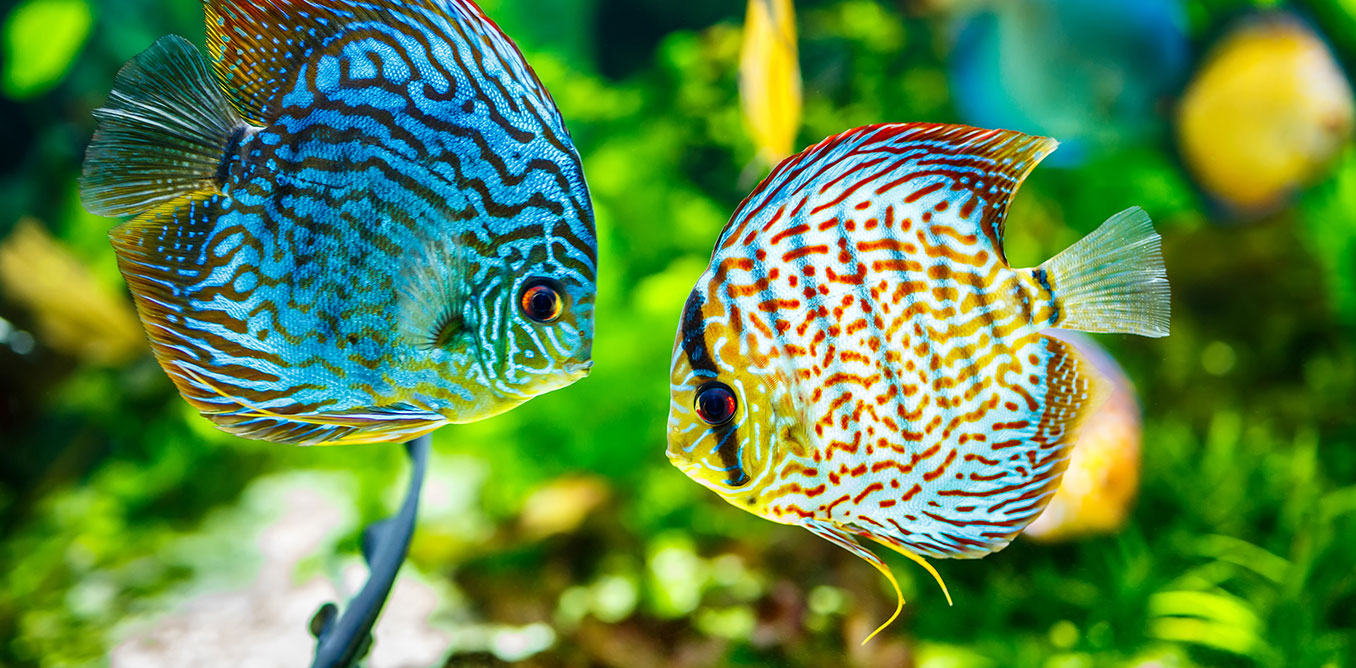
Discus care sheet
FAMILY: The Symphysodon, colloquially known as discus, is from the cichlid family, native to the Amazon River basin in South America. Due to their distinctive shape, bright colors and interactive behaviour, discus make a popular freshwater aquarium fish.
APPEARANCE: The body of the discus fish is round, compressed, and as the name suggest disc-like. Colouration is a distinctive feature of these fish, and colour will differ greatly depending on the variety.
SELECTION: When selecting discus, health is more important than the variety or even the colour of the fish. The fish should rush towards you, looking for food and should have a uniform, rounded shape, free from wounds and deformities. Fins should be evenly shaped and the eyes clear, bright and appropriate to the size of the fish.
HOUSING: Relative to other fish, discus are harder to look after, though recent improvements in filter design and efficiency have improved the ability to care for them more effectively. Water quality, temperature, feeding and health are all significant factors which must be diligently observed for there to be any success in keeping these beautiful fish.
Firstly, the tank must be ready and the filter cultured before bringing the discus home. The water conditions must calibrate specifically to only suit this type of fish Tanks should be of a generous size o allow plenty of swimming space as they can be territorial at times and don’t like to be overcrowded.
WATER PARAMETERS: Discus requires warm water. Low water temperatures are stressful, and the discus will suffer overtime, being especially prone to intestinal parasites. Best temperature range for discus is 28C-30C. Tap water should be treated to remove CHLORINE and CHLORAMINE and the pH adjusted. Discus do well in soft (low in calcium), acidic water. Keep the pH between 5.0 and 6.0. Discuses grow faster in acidic water, their skin slime is thicker, and they ward off disease better. It is very important that when you set up your tank, you approximate the water conditions that your fish have previously been living in. Full grown discus requires a water change once a week, 30-40% of the total tank water. However, smaller more frequent water changes are also beneficial.
FEEDING: To keep discus healthy they need to be feed a varied diet. Adults require a good quality flake or
pellet food at least once a day. Discus are carnivorous and require frozen or live food regularly. Frozen blood worms, brine shrimp and beef heart are all suitable. Discus are generally not fussy eaters, unless they are in some distress. Ideally to grow discus from about 5cm (2”) in size, they should be fed four to five times per day, while 10cm (4”) discus can be fed twice a day. Don’t give discus more than they will eat in an hour and siphon out any leftover food and hour or two after each feeding. Discus are greedy eaters for the first few minutes, but then they like to nibble, so don’t be too quick to remover the leftovers.
WHEN YOU GET THE FISH HOME: When you get the fish home, it is important to acclimatise them to your tank’s environment. Float the transport bag in the tank water for at least 20 minutes, in order to acclimatise the fish to the temperature. Then slowly drip the cultured tank water into the transport water until the volume in the bag is doubled. Once doubled, you can move the fish into your tank – don’t introduce the bagged water into the tank.
Until settled in, discus are likely to be skittish and dart around the tank when approached. However, over time they will become accustomed to their new surroundings and will swim to the front of the tank looking for food. Keep the lights low and don’t feed them for the first day. Initially avoid interfering with the fish unless it is necessary. If this is the first time keeping discus, consider initially keeping the tank bare, except for filter, heater and light. This allows observing discus closely, waiting about two weeks before adding plants and ornaments.
There is no problem with keeping the bottom of the tank bare, this will minimise contamination and ease cleaning. However, a thin layer of very fine gravel on the bottom can make siphoning easier as the gravel helps to trap waste. The fish may also appreciate the gravel and may be seen blowing into it as they hunt for food. If you do use bare bottom tanks, be sure to paint or otherwise cover the outside of the bottom glass, as the fish do not do well if they can see through the bottom, it disorients them, and they remain skittish and shy.
